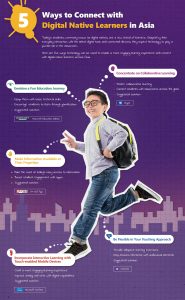The digitally-driven environment of today has given rise to a new generation of learners. Here is how you better engage them with technology and deliver a richer learning experience.
1. Make information available at their fingertips
Computing devices and the internet have become fixtures in the lives of modern-day students, who are accustomed to being always connected and having instant access to information. The use of educational apps can provide these digital native learners easier access to vast amounts of educational resources—in and outside the classroom—and help them manage their academic schedules and workloads.
In Malaysia, Asia Pacific University was able to boost student engagement with the LP+365 app. Using the app, students can access daily calendars, assignments and curriculum material on a single platform. This gives the students more control over their learning experience, by having classroom materials and other relevant resources information easily available at their fingertips.
2. Incorporate interactive learning with touch-enabled mobile devices

With rapid mobile proliferation in Asia, educational institutions have a unique opportunity to tap the advantages of mobile technology to transform classroom learning. With the right lessons and mobile strategy in place, educators can craft interactive learning experiences to equip students with digital skills.
Consider how in a traditional classroom setting, an educator may be saddled with having to explain theory-heavy STEM concepts using drawings or a physical model. Mobile devices open up the possibility for students to have a more interactive experience with the existing education material, while improving analog skill sets with digital capabilities. For instance, by incorporating touch- and stylus-enabled mobile devices, such as the Microsoft Surface, students can gain opportunities for unique hybrid forms of interaction, like accessing 3D applications to render a drawing of the human anatomy into a fully interactive graphical object.
3. Concentrate on collaborative learning
Digital collaboration tools have shown promise in successfully fostering collaborative learning among digital native learners. In the United States, teachers from Fresno Unified School District discovered that as classes collaborate more digitally to provide new ways to learn, the students themselves began to collaborate more often—and more frequently with their peers. Beyond in-class collaboration, online tools such as Mystery Skype further enable teachers to customize exercises and link their students with classrooms across the globe.
4. Envision a fun education journey
Online and video gaming are popular sources of entertainment in the lives of digital natives—and the engaging nature of gameplay can be tapped to get students more excited about learning or to teach them basic technical skills such as coding principles.
Forward-thinking educators are now starting to incorporate game-based learning activities and gamification techniques into the classroom to capture students’ attention in new, innovative ways—ultimately, encouraging them to learn through play. At Tun Muhammad Fuad Stephens School in Malaysia, a student shares about the excitement of learning through Minecraft: Education Edition and how it has enhanced teamwork in the classroom.
5. Be flexible in your teaching approach
While a traditional teaching approach may have worked in the past, learners today appreciate having more flexibility throughout their learning journey. As a result, educators need to rethink how they are reaching out to their students in the classroom. This might mean depending less on regimented schedules and supporting learners with a more personalized approach.
With the help of tools like OneNote, educators can provide students with adaptive learning exercises that fit different learning experiences, while keeping the lesson interactive with audio and video recordings in customized lesson plans.
Learn more about how teachers today can leverage new technology to not only make lessons relevant to student needs, but also impactful, engaging, and inspiring at Microsoft Education or the Microsoft Educator Community Portal.





